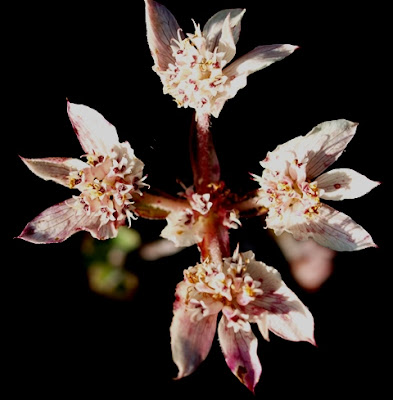Well, is this Xanthosia from Maranoa Garden a carrot or what?
The last thing I thought I'd be investigating after my second visit (after a 20-year gap) to Maranoa Gardens in Balwyn was whether a flower I photographed was a carrot, or not. Well not literally a carrot, but one of its close relatives.
Maranoa Gardens is all about Australian plants, and the carrot or celery family is not generally the first thing you think of when you think natives. As it happens, the carrot family is nicely represented in Australia by things like the Flannel Flower (Actinotus) and the lacy Platysace, both featuring strongly in the bush near our previous home on Sydney's North Shore. The carrot (Daucus) is clearly represented in our gardens, shops and fridges, with its wild relatives rampaging nicely along many a roadside.
While in Sydney I could have excluded Xanthosia (the plant photographed) from the list but now that I'm back in Melbourne I'm can bring it back home to the Apiaceae, the carrot family. Not because there is some kind of crazy intercity rivalry about naming native carrot allies, but because things change.
For a short while Xanthosia was shuffled off to its own family, Mackinlayaceae, with five other genera. This was based on the latest DNA sequencing and analyses, by the important-sounding Angiosperm Phylogeny Group II. Since then (2001) the classification of flowering plants has been revised, and version III (2009) has these genera returning to the Apiaceae, albeit as part of a subfamily we now call Mackinlayoideae.
The namesake of the family, Mackinlaya, is a large-leaved tropical plant that has been traditionally shelved in the family Araliaceae, nestled in with the umbrella tree and ivy. When Mackinlayaceae was created in 2001, it brought together plants from the Araliaceae and the Apiaceae. They have stayed grouped together in the third iteration but nestled within the carrot family (Apiaceae).
So this Xanthosia thing is obviously a bit different to your regular carrot or flannel flower. There are about 20 species but the Xanthosia around Sydney were not much to write a blog about. They were grey and blankety, with nondescript flowers. The Maranoa Gardens' species, Xanthosia rotundifolia from Albany in south-western Australia, is something else. The flower clusters are striking, with the distinctive X-shaped arrangement (even in this rather poor picture of a redder cluster of flowers and bracts) giving rise to its common name Southern Cross.
On the day, neither Lynda or I could identify this plant or even what it might be related to. With puzzled looks on our faces we ran into Paul Birch, curator of Maranoa Gardens, out planting yet more Australian natives.
To our horror he noticed Lynda had a flower of the Xanthosia sticking out of her top pocket. A little embarrassing in a garden where, like a botanic garden, you are not meant to pick flowers. Of course we explained it was for the sake of science, for the sake of educating the Director of the Royal Botanic Gardens, and for goodness sake it's just one flower! As it happens, Paul has a very tolerant and pragmatic approach to the garden and wasn't fussed at all.
The obvious question is what makes this genus different enough from other carroty plants to be sometimes shuffled into another family? There are some fine details of the flower and fruit anatomy, and certainly some genes, but not much that you or I could see at Maranoa Gardens I'm afraid.
Instead, here are a few more pretty plants from Maranoa: Epacris purpurascens from New South Wales, Hakea orhorrhyncna from Western Australia and there very own Wollemia nobilis from just north of Sydney somewhere...







Comments
Tim